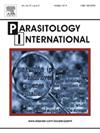First record of Brachylaima asakawai (Trematoda: Brachylaimidae) in a carnivore host, the red fox (Vulpes vulpes schrencki)
IF 1.5
4区 医学
Q3 PARASITOLOGY
引用次数: 0
Abstract
Accumulating information on the relationship between hosts and parasites is important to understand their life cycle. Nine Brachylaima spp. species exist in Japan, but their life cycles are not fully understood, partly because of their low prevalence in their definitive hosts. In this study, 23 trematodes, thought to belong to the genus Brachylyma were found in the small intestine of the red fox (Vulpes vulpes schrencki) in Hokkaido, Japan. We analyzed these trematodes using morphological and molecular methods. Morphological analysis showed that the trematodes had the same features as Brachylaima asakawai. We extracted DNA from the trematodes and amplified the nuclear 28S ribosomal RNA (28S rDNA) and mitochondrial cytochrome c oxidase subunit 1 (cox1) genes. The 28S rDNA and cox1 fragments were 100 % and 99.7 % identical to the B. asakawai, respectively. Previously, B. asakawai was detected only in rodents in Hokkaido; however, this study demonstrated that it is also a fox parasite. This is the second report of a definitive natural host for B. asakawai and the first record of the red fox being found as a new definitive host for B. asakawai. To fully understand the host preference and range of B. asakawai, it is essential to continuously survey various animals to understand the life cycle of B. asakawai completely.

赤狐(Vulpes Vulpes schrencki)在食肉寄主赤狐(Vulpes Vulpes schrencki)中的首次记录
积累有关寄主和寄生虫之间关系的信息对于了解它们的生命周期非常重要。日本存在9种短囊藻,但它们的生命周期尚不完全清楚,部分原因是它们在最终宿主中的流行率较低。本研究在日本北海道的红狐(Vulpes Vulpes schrencki)的小肠中发现23种吸虫,被认为属于短囊虫属。我们对这些吸虫进行了形态学和分子分析。形态分析表明该吸虫具有与浅川短臂线虫相同的特征。提取吸虫DNA,扩增核28S核糖体RNA (28S rDNA)和线粒体细胞色素c氧化酶亚基1 (cox1)基因。28S rDNA和cox1片段与asakawai b的同源性分别为100%和99.7%。以前只在北海道的鼠类中发现浅川白僵菌;然而,这项研究表明,它也是一种狐狸寄生虫。这是第二次报告浅川白蛉的确定自然寄主,也是第一次发现赤狐作为浅川白蛉新的确定寄主。为了充分了解浅川夜蛾的寄主偏好和分布范围,有必要对各种动物进行持续调查,以全面了解浅川夜蛾的生命周期。
本文章由计算机程序翻译,如有差异,请以英文原文为准。
求助全文
约1分钟内获得全文
求助全文
来源期刊

Parasitology International
医学-寄生虫学
CiteScore
4.00
自引率
10.50%
发文量
140
审稿时长
61 days
期刊介绍:
Parasitology International provides a medium for rapid, carefully reviewed publications in the field of human and animal parasitology. Original papers, rapid communications, and original case reports from all geographical areas and covering all parasitological disciplines, including structure, immunology, cell biology, biochemistry, molecular biology, and systematics, may be submitted. Reviews on recent developments are invited regularly, but suggestions in this respect are welcome. Letters to the Editor commenting on any aspect of the Journal are also welcome.
 求助内容:
求助内容: 应助结果提醒方式:
应助结果提醒方式:


